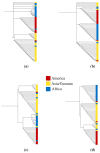A PCR-RFLP Technique to Assess the Geographic Origin of Plasmodium falciparum Strains in Central America
- PMID: 35893657
- PMCID: PMC9394469
- DOI: 10.3390/tropicalmed7080149
A PCR-RFLP Technique to Assess the Geographic Origin of Plasmodium falciparum Strains in Central America
Abstract
The elimination of malaria requires strengthening diagnosis and offering adequate and timely treatment. Imported cases of falciparum malaria represent a major challenge for pre-elimination areas, such as Central America, where chloroquine and primaquine continue to be used as first-line treatment. The pfs47 gene has been previously described as a precise molecular marker to track the geographic origin of the parasite. The aim of this study was to design a simple and low-cost technique using the polymorphic region of pfs47 to assess the geographic origin of P. falciparum strains. A PCR-RFLP technique was developed and evaluated using the MseI enzyme that proved capable of discriminating, with reasonable precision, the geographical origin of the parasites. This method could be used by national surveillance laboratories and malaria elimination programs in countries such as Honduras and Nicaragua in cases of malaria where an origin outside the Central American isthmus is suspected.
Keywords: Central America; Honduras; Plasmodium falciparum; malaria; pfs47; pfs48/45; pvs47.
Conflict of interest statement
The authors declare no conflict of interest.
Figures





Similar articles
-
A genotyping assay to determine geographic origin and transmission potential of Plasmodium falciparum malaria cases.Commun Biol. 2021 Sep 30;4(1):1145. doi: 10.1038/s42003-021-02667-0. Commun Biol. 2021. PMID: 34593959 Free PMC article.
-
Deletions of pfhrp2 and pfhrp3 genes of Plasmodium falciparum from Honduras, Guatemala and Nicaragua.Malar J. 2018 Aug 31;17(1):320. doi: 10.1186/s12936-018-2470-7. Malar J. 2018. PMID: 30170596 Free PMC article.
-
Assessment of Plasmodium falciparum anti-malarial drug resistance markers in pfcrt and pfmdr1 genes in isolates from Honduras and Nicaragua, 2018-2021.Malar J. 2021 Dec 14;20(1):465. doi: 10.1186/s12936-021-03977-8. Malar J. 2021. PMID: 34906144 Free PMC article.
-
[Role of primaquine in malaria control and elimination in French-speaking Africa].Bull Soc Pathol Exot. 2017 Aug;110(3):198-206. doi: 10.1007/s13149-017-0556-z. Epub 2017 Apr 17. Bull Soc Pathol Exot. 2017. PMID: 28417346 Review. French.
-
Malaria in Brazil, Colombia, Peru and Venezuela: current challenges in malaria control and elimination.Malar J. 2017 Jul 4;16(1):273. doi: 10.1186/s12936-017-1925-6. Malar J. 2017. PMID: 28676055 Free PMC article. Review.
Cited by
-
Advocating for PCR-RFLP as molecular tool within malaria programs in low endemic areas and low resource settings.PLoS Negl Trop Dis. 2023 Nov 8;17(11):e0011747. doi: 10.1371/journal.pntd.0011747. eCollection 2023 Nov. PLoS Negl Trop Dis. 2023. PMID: 37939114 Free PMC article.
References
-
- World Health Organization . World Malaria Report 2021. WHO; Geneva, Switzerland: 2021.
-
- World Health Organization . World Malaria Report 2014. WHO; Geneva, Switzerland: 2014.
-
- Nieto-Zelaya V., Vanessa G., Alvarado-Claros J., García J., Alger S., Tovar-Calderón J. Navarro, School child with Plasmodium falciparum malaria from Africa: Public health risk in Honduras. Rev. Med. Hondur. 2019;87:20–26.
-
- Higuita N.A., Suarez J.A., Millender E., Creighton E.G., Corbisiero M.F., Freites C.O., Cordero J.H., Kousari A., Unterborn R., Marcos L.A., et al. bound journey of migrant peoples InTransit across Dante’s Inferno and Purgatory in the Americas. Travel Med. Infect. Dis. 2022;47:102317. doi: 10.1016/j.tmaid.2022.102317. - DOI - PubMed
LinkOut - more resources
Full Text Sources

